Kids will love this rainbow variation on the classic naked eggs experiment. Don’t just try the rubber egg experiment without color, make rainbow rubber eggs instead! My kids like colorful, dramatic science experiments for kids. There is nothing tame or boring about making this rainbow rubber egg experiment! This experiment has both the “wow” factor and the gross factor that will make confirmed science lovers for life. We used this experiment as a fun addition to our Easter STEM activities, but you can also use it for a St. Patrick’s Day STEM activity or any time of year!
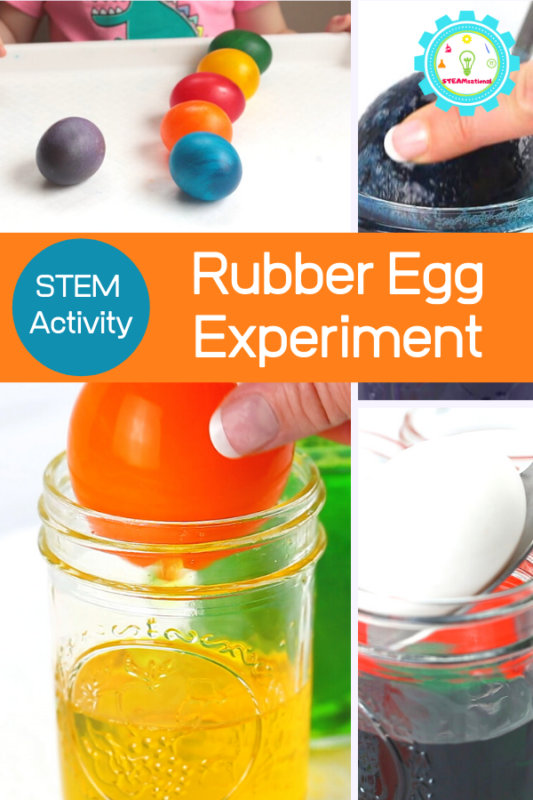
You can also try the rainbow version of this experiment for any egg in vinegar science fair project.
Table of Contents
What to Know Before Doing the Rainbow Rubber Egg Experiment
Here is what you need to know to teach kids about the science of the rainbow rubber egg experiment and the supplies you need to complete this colorful springtime STEM activity!
You can also use this activity as part of your St. Patrick’s Day activities, egg activities for kids, or rainbow science experiments!
How do you make a rainbow rubber egg?
Here is everything you need to know about the egg in vinegar science experiment so you can make your on rainbow
Did you know that inside of every egg shell is a membrane holding the “guts” of the egg in place?
This membrane is located between the egg shell and the egg white. There are actually two layers of membrane inside every egg (called inner and outer membrane, not to be too on the nose).
The membranes protect the growing chick from exposure to bacteria, but the membranes are semi-permeable, which is how the dye used in this experiment colors the eggs and why they get bigger when placed in water or vinegar.
The egg membrane is strong, which is how you can play with it and bounce it without breaking it (of course, too much pressure will burst the eggs, causing a huge mess!).
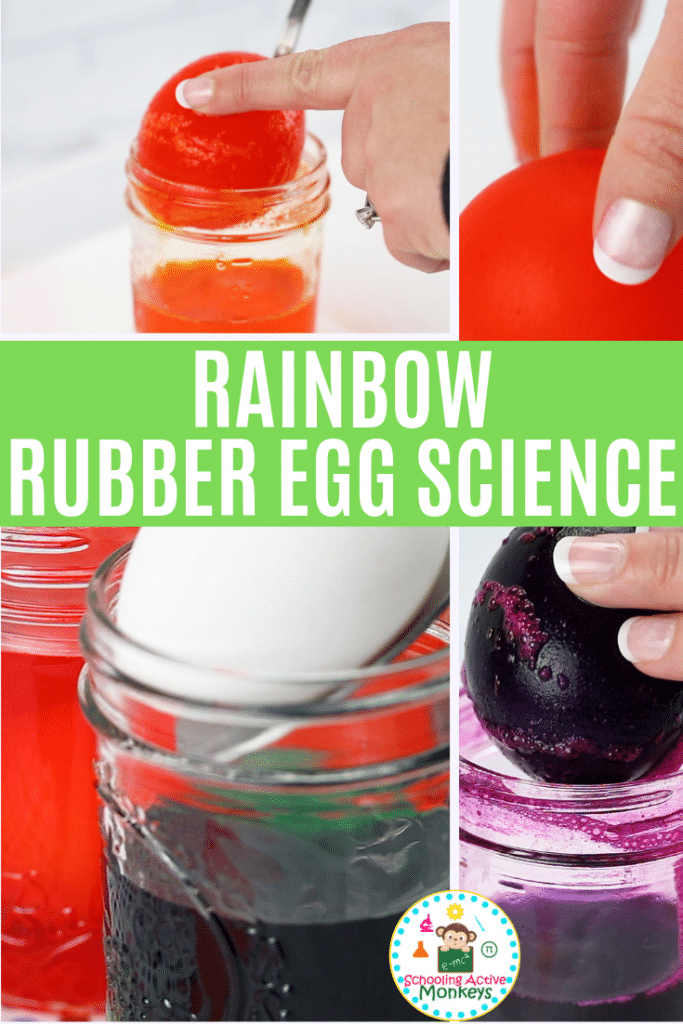
Fun fact: There is also keratin inside an egg membrane, which is present in human hair.
When the acid in the vinegar eats through the calcium shell, the membrane is left encasing the egg. The texture feels rubbery, hence, the rubber egg.
STEM questions to ask when doing this rainbow rubber egg experiment
Transform this bouncy egg experiment into a STEM project by asking a few extra questions and adding variables.
- Will shells dissolve in different materials?
- What happens if you use a different kind of dye?
- Will eggs change color without the help of vinegar?
Experiment with different liquids, like soda, water with baking soda added, milk, coffee, water, and oil.
What was the observation in the rubber egg experiment?
After removing the eggs from the vinegar, watch what happens when you let them sit out on the counter without any liquid.
- Do they dry out?
- What happens if you put the eggs in a salt solution?

How many days does the rubber egg experiment take?
Depending on how strong your egg shells are, it will take anywhere from 24 hours to 72 hours for the vinegar to dissolve all the calcium of the egg shells, revealing the colorful egg membranes below.
What you’ll need to make the egg in vinegar experiment:
This post contains affiliate links at no cost to you for your convenience.
What does the rubber egg experiment teach us?
The osmosis experiment for kids teaches children how liquid moves through a membrane. The addition of dye to the rubber egg experiment can show how osmosis works.
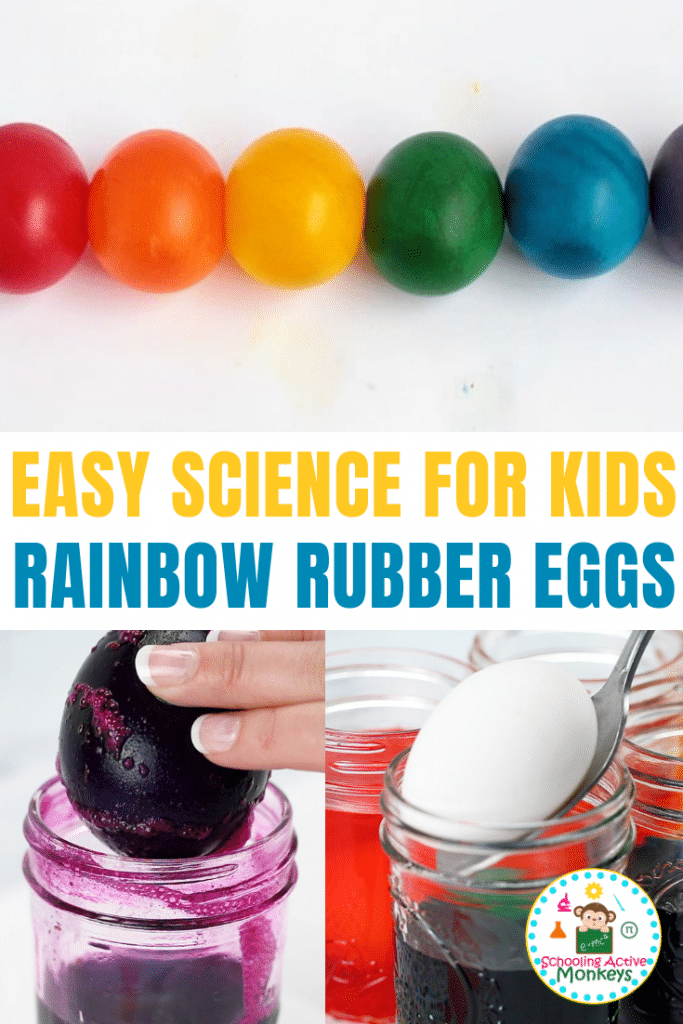
For the main rainbow naked egg experiment, however, the scientific concept is a chemical reaction and a lesson in dissolving.
The vinegar eats through the calcium shell, but cannot dissolve the egg’s membrane, which is how the eggs retain their rubbery appearance after the experiment is complete.
The egg membrane is semi-permeable, which simply means that the liquid vinegar will pass through the membrane into the egg.
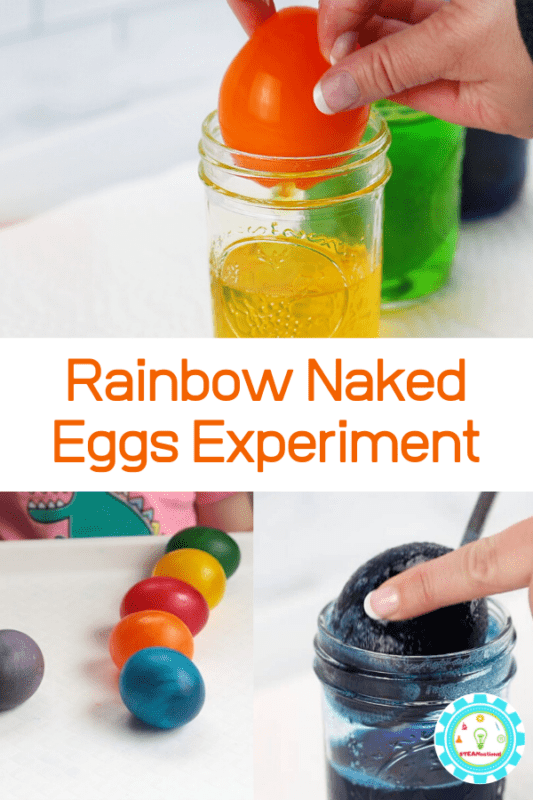
When the vinegar is dyed, the dye and the vinegar seep into the egg white, creating fun rainbow colors! The brighter the dye that you use, the brighter your egg rainbow will be!
Rubber Eggs Experiment Directions
Follow along with these printable directions to learn how to transform this simple egg science activity into a complete STEM lesson plan!
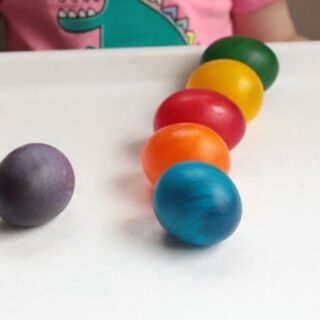
Rainbow Rubber Eggs Naked Egg Experiment
Kids will love this rainbow variation on the classic naked eggs experiment. Don't just try the rubber egg experiment without color, make rainbow rubber eggs instead!
Materials
- Food coloring
- 6 jars
- Vinegar
Tools
- Spoon
- Measuring cup
Instructions
- Fill each container about 1/2 full of vinegar. Add about 10 drops of food coloring to each jar.
- Carefully place a raw egg inside each jar. Let the eggs sit for about 48-72 hours in the vinegar.
- Try putting other eggs in different liquids to see if they produce a different or similar reaction.
- When the surface of the water has a weird scummy film, the eggs are ready to come out.
- Remove the eggs from the jars (carefully) and rinse them in water. They are completely colored!
- Gently roll and bounce the eggs and watch what happens!
- When the kids are done admiring the eggs, break them open. The kids might be surprised to see that the egg yolk is still yellow! The high protein content of the yolk prevents the egg's cells from absorbing the colored liquid that is absorbed by the rest of the egg.

